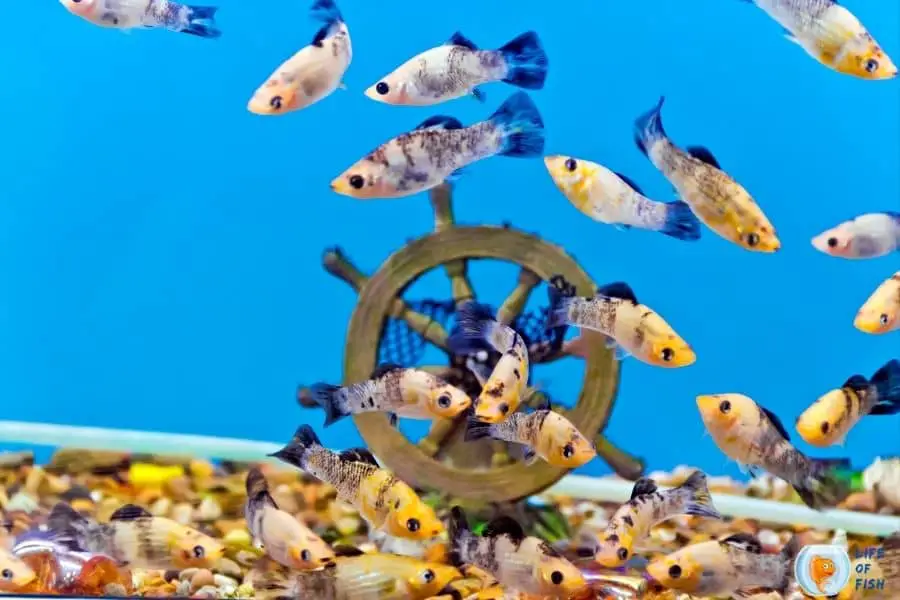Caring for your fish is fun and exciting until your fish looks abnormal. When a fish swims vertically, that indicates a problem. But what exactly is that? You are desperate to know.
Fish swim vertically for several reasons. It abnormally swims when stressed, pregnant, and most commonly infected with swim bladder disease.
Knowing that bit of information isn’t enough for you to cure your vertically swimming fish. So, read this article to learn in-depth about the reasons, cures, and how to prevent this situation.

Why is my fish swimming vertically?
Jump To
- 1 Why is my fish swimming vertically?
- 2 Why is my fish swimming vertically, nose up?
- 3 Why is my fish swimming vertically head down?
- 4 How can I prevent my fish from swimming vertically?
- 5 Swim bladder disease
- 6 What causes swim bladder in fish?
- 7 Swim Bladder Disorder symptoms
- 8 How long can a fish live with swim bladder disease?
- 9 Is swim bladder disease contagious?
- 10 How do you treat swim bladder disease?
- 11 How to prevent swim bladder disease?
- 12 Conclusion
Fish swim vertically for several reasons. Some of the reasons are easy to fix, while one is rather complicated and needs good care. They are,
Stress
When a fish is stressed, it may swim erratically, and vertical position is one way of showing its stress.
Fish often become stressed when they are introduced to a new aquarium, being chased by a predator fish, when food is just placed in the tank and many more reasons.
Stress usually resolves itself without any intervention from owners or fishkeepers. To cure it, you just need to wait for a few days until the fish get used to the new environment or whatever has been causing their stress to dissipate.
Pregnancy
When a female fish is carrying eggs, she will often swim vertically and might even stop eating.
In fact, some females will stop swimming altogether and sink to the bottom of the tank. This behavior is normal, and you can do nothing until the eggs are hatched, and the fry is released.
Swim Bladder Disease
The most common reason for a fish to swim vertically is an infection of the swim bladder. Swim bladder disease can be caused by many things, such as bacterial, viral, and parasitic infections, constipation, and high levels of nitrates and ammonia in the water.
Swim bladder disease is a severe condition and requires immediate treatment. The fish will usually need to be placed in a quarantine tank and treated with antibiotics, anti-parasitic drugs, and/or anti-viral drugs.
Why is my fish swimming vertically, nose up?
If your fish is swimming vertically nose up, that could mean any of the reasons mentioned above. Usually, fish swim vertically heads up when they can’t breathe easily.
This can happen when they are stressed, when the water quality is poor, when pregnant, and when they suffer from swim bladder disease.
Swim bladder disease is the most common reason for a fish swimming vertically with its nose up. In this condition, fish swims up to breathe air into the swim bladder, making the fish more buoyant.
As the fish gets more buoyant, the fish starts to rise towards the surface. So, this will look like the fish swims upwards with its nose up.
Why is my fish swimming vertically head down?
When fish are swimming vertically, head down, it always means that they suffer from swim bladder disease.
While fish swim upwards to breathe air, they swim downwards to release air from the swim bladder.
If you see your fish swims vertically head down, that means the fish is trying to release air from its swim bladder. You will also see air bubbles coming out of your fish’s mouth as it swims downwards.
How can I prevent my fish from swimming vertically?
There is no surefire way to prevent your fish from swimming vertically, but there are some things you can fix to minimize the chances of it happening. To prevent your fish from swimming vertically, you should,
- Keep the aquarium clean and free of waste
- Do regular water changes
- Monitor the levels of ammonia and nitrates in the water
- Feed your fish a healthy diet
- Provide enough hiding places for your fish
- Quarantine new fish before introducing them to the main tank
- Avoid overfeeding your fish
- Introduce new fish slowly to the main tank
By following this advice, you can help reduce the stress on your fish and minimize the chances of them swimming vertically. If your fish does start to swim vertically, please take them to a veterinarian for treatment.
While these are general steps to avoid fish swimming vertically, we said that the leading cause for this behavior is Swim Bladder Disease. So, it is essential to know about swim bladder disease, its treatment options, and how to prevent it.

Swim bladder disease
Swim bladder disease is a common and severe condition that affects much fish. The swim bladder is a gas-filled organ located in the fish’s abdomen.
This organ helps the fish to maintain buoyancy. The fish’s digestive system regulates the gas in the swim bladder, so digestion problems will affect the swim bladder, affecting the fish’s buoyancy.
Many things can cause swim bladder diseases, such as bacterial, viral, and parasitic infections, constipation, and high levels of nitrates and ammonia in the water.
Fish with a healthy digestive system will naturally release air from their swim bladder. However, fish with problems in the digestive system will struggle to release air from their swim bladder, which causes them to become buoyant.
These fish will often face difficulties controlling their movement, and they may have problems maintaining neutral buoyancy.
What causes swim bladder in fish?
There are various things that can lead to swim bladder issues in fish. The most common causes of swim bladder disease are,
- Bacterial infections – Bacterial infections can cause swim bladder disease by damaging the fish’s digestive system.
- Viral infections – Viral infections can damage the fish’s organs. One of the organs that may be affected by this disease is the swim bladder.
- Parasitic infections – Parasitic infections can also damage fish’s organs, including the swim bladder.
- Constipation – Constipation can be caused by a number of things, one of which is the build-up of undigested waste in the fish’s intestine. This can cause the fish to become buoyant and have difficulty swimming.
- High levels of ammonia and nitrates – High levels of ammonia and nitrates in the water can cause the fish’s swim bladder to swell. This will make it difficult for the fish to swim and may even cause death.
- Nutritional deficiencies- A lack of certain vitamins and minerals can also lead to swim bladder problems in fish.
- Physical damage to the swim bladder- A fish’s swim bladder may also be affected by physical damage, and this can happen if the fish becomes trapped in a fishing line or is attacked by another fish.
Swim Bladder Disorder symptoms
If your fish suffer from swim bladder disease, there are a few symptoms you will likely see,
- Fish swimming vertically- As we mentioned earlier, this is one of the most common symptoms of swim bladder disease.
- Floating at the surface- Another common symptom of swim bladder disease is when the fish floats at the water’s surface.
- Fish unable to swim down- If your fish have difficulty swimming down, they are likely suffering from swim bladder disease.
- Holding their breath- Fish with a problem with their swim bladder may also struggle to breathe. They will take quick and shallow breaths.
- Fish struggling to eat- If your fish is suffering from swim bladder disease, they will likely have difficulties eating. This is because the fish is having trouble getting food to the back of their throat.
- Fish regurgitating food- Fish that are struggling to eat may also begin to regurgitate their food.
How long can a fish live with swim bladder disease?
Swim bladder disease can be temporary if the fish gets it from an infection or a viral disease.
However, in rare cases, this swim bladder disorder becomes permanent. If your fish is healthy, otherwise, your fish can live a full and happy life with swim bladder disease if you do some modifications in their lifestyle.
You will have to keep pristine water conditions along with some diet changes, changes in the tank decorations, and changes in how you feed them. If you take care of your bloated fish dearly, your fish can live a long life.
But, if your fish has caught this disease due to a viral infection and you haven’t treated it with medications, unfortunately, you won’t be able to get rid of the disease. Eventually, your fish will become weaker and weaker until it dies.
Is swim bladder disease contagious?
Swim bladder disease itself is not contagious. But, the things that can lead to swim bladder disease, such as bacterial and viral infections, are contagious.
So, if your fish is infected with one of these diseases, it will be contagious to other fish. Also, if you have a tank mate that is suffering from swim bladder disease, make sure to quarantine it.

How do you treat swim bladder disease?
If your fish suffer from swim bladder disorder, there are a few treatments that you can do.
Raise the temperature
If your fish caught swim bladder disease due to an infection, raising the water’s temperature can help kill the bacteria. This will provide your fish a chance to fight the disease and cure itself.
Fasting
If fish has got swim bladder disease due to constipation, stop feeding your fish for the next three days. This will give your fish time to digest undigested food and help cure swim bladder disorder.
Water changes
If your fish has got swim bladder disease because of the water conditions, the best way to cure it is to perform a water change. Water changes will help your fish get back healthy and also remove all the impurities from the water.
Feed peas
For constipation-related swim bladder disease, peas work wonders. Cooked, skinned, and crushed peas can cure constipation naturally if fed two to three times per day. Do not feed any other food until your fish recovers.
Medications
If your fish has caught swim bladder disease because of a viral infection, you will have to use medications to cure it.
There are a lot of medicines in the market that can help cure swim bladder disease. However, when you are choosing between medications for your fish, make sure to use a trusted one. Many medicines in the market contain harmful chemicals and can kill your fish.
Salt
If your fish is suffering from swim bladder disease because of a bacterial infection, you can cure it by adding salt to the water. Salt will kill all the bacteria in the water and will help your fish get rid of the infection.
There are a number of ways that you can help your fish fight swim bladder disease. By using some of these treatments, your fish can get back to its healthy and active self.
While you treat your fish, it is important to keep the water clean. Make sure to do regular water changes and check the water conditions often. This will help your fish get better faster.
How to prevent swim bladder disease?
There are a few things that you can do to prevent swim bladder disease in your fish.
- Regular water changes– One of the best things that you can do to prevent swim bladder disease is to perform regular water changes. If your fish gets constipated, changing the water will flush out all the impurities and will help to cure the disease.
- Good water conditions– Make sure to keep your tank water conditions in good condition. Always keep an eye on your water parameters and get them fixed if they are out of the desired range. Water changes will help to keep the water conditions good.
- Quarantine new fish– When you get a new fish, make sure to quarantine it for at least two weeks. During this time, keep a close lookout for your new fish and make sure to feed it properly. This will help you know if your new fish is healthy or not.
- Do not overfeed– If you are feeding your fish too much food, it will most likely get constipated. Ensure to feed your fish only as much as it can eat in a minute and remove all the uneaten food afterward.
- Do not starve– You mustn’t starve your fish of food. If you are not feeding your fish for a long time, it will get constipated.
- Keep your filter running– If you are not maintaining your tank’s filter, there is a high chance that it will get clogged. This will lead to poor water conditions and can cause swim bladder disease in your fish.
While there is no sure way to prevent swim bladder disease, following some of these tips can help reduce the chances of your fish getting infected. By keeping a close watch on your water conditions and the food you feed your fish, you can make sure swim bladder disease does not affect it.
Conclusion
Fish swim vertically when they are stressed, pregnant, and suffer from swim bladder disease. While former situations are normal and can be corrected easily, the latter is much difficult and can be dangerous for your fish.
It is important to treat swim bladder disease as soon as you notice the symptoms to prevent fatalities.
Many treatments are available for swim bladder disease, but the best way to treat it is to find the root cause behind the swim bladder infection.
By finding out the root cause, you can make sure your fish recovers quickly and does not get affected by swim bladder disease again in the future.
Read Next : Do Fish Fins Grow Back? (Surprisingly, Yes !) What Do Minnows Eat? (They Are Pickier Than You Think! ) Why Do Fish Become Aggressive? ( It is Not A Simple Answer! )

